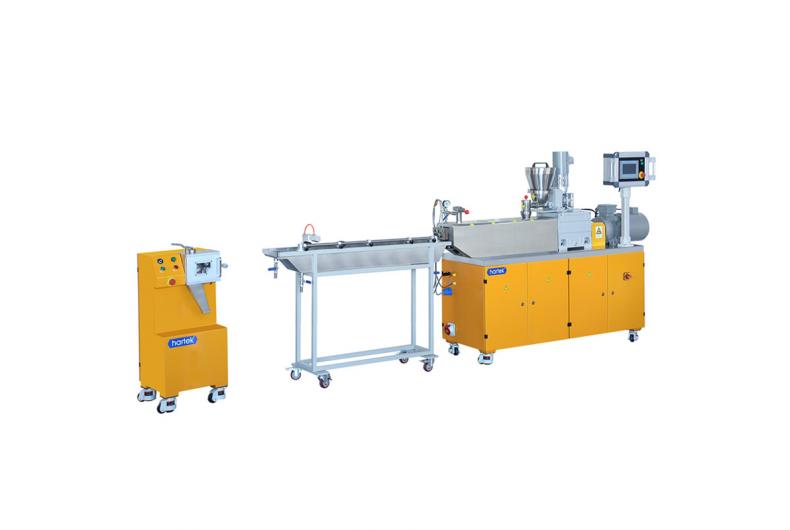Structure and working principle
The laboratory single screw extruder is mainly composed of a screw, a barrel, a heating/cooling system, a transmission system and an intelligent control system. Its working principle is based on the rotation of the screw to gradually plasticize, mix and extrude solid materials (such as polymer particles or powders). The screw is usually divided into three sections:
1. Conveying section: The material is pushed forward and preheated in the form of a “solid plug”, relying on friction and mechanical compression.
2. Compression section: The volume of the screw groove gradually decreases, and the material is melted and plasticized by shear heat and external heating. The compression ratio is usually 3:1.
3. Metering section: The melt is further homogenized and quantitatively conveyed to the die, and formed into a specific shape (such as film, pipe or granules) through the mold.

Key features of Laboratory single screw extruder:
Compared with industrial equipment, laboratory models focus more on flexibility, accuracy and data acquisition capabilities:
1. High-precision control
– Temperature control accuracy reaches ±1.0℃, and melt pressure measurement error is ≤0.2%.
– Equipped with international brand sensors (such as Hartek extruder) and computer measurement and control systems to monitor melt pressure, temperature and torque in real time.
2. Modular design
– Screws and molds with different aspect ratios (L/D 28:1 to 33:1) can be replaced to meet various experimental needs such as granulation, cast film, and pipes.
– Support rheological test molds (such as slit type and round rod type) to directly measure the shear viscosity and elasticity of materials.
3. Safety and intelligence
– Integrated emergency stop device, automatic temperature control and interlock protection system to ensure safe operation.
– Computer control of peripheral equipment (such as feeding and pelletizing) to improve experimental repeatability.
Application:
1. Material research and development and formulation optimization
– Development of new polymer materials (such as biodegradable plastics, conductive polymers).
– Test the effect of additives (flame retardants, UV stabilizers) on material properties.
2. Process parameter verification
– Simulate industrial production conditions and optimize parameters such as temperature and speed.
– Study the rheological behavior of materials (such as viscosity and melt fracture characteristics).
3. Sample preparation
– Prepare films, fibers, 3D printing wires or granules for subsequent mechanical and optical testing.
– Used in the pharmaceutical industry for hot melt extrusion (HME) technology to improve drug solubility.
Technical Parameters of Lab Single Screw Extruder:
| Model | HTES-20 | HTES-25 | HTES-30 | HTES-35 | ||
| Screw Diameter | (mm) | 20 | 25 | 30 | 35 | |
| L/D Ratio | (L/D) | 28 | 28 | 30 | 30 | |
| Power | (kW) | 3 | 4 | 5.5 | 7.5 | |
| Rotating Speed | (rpm) | 120 | 120 | 120 | 120 | |
| Max. Temp | (℃) | 350 | 350 | 350 | 350 | |
| Temp Control Accuracy | (℃) | ±1 | ±1 | ±1 | ±1 | |
| Pressure Measuring Range | (MPa) | 0~35 | 0~35 | 0~35 | 0~35 | |
| Output | (kg/h) | 0.5~3 | 0.5~5 | 0.5~7 | 0.5~10 | |
| Weight | (kg) | 296 | 325 | 348 | 370 | |
| Dimesion | (L×W×H) | mm) | 1120×1115×1660 | 1260×1115×1660 | 1460×1115×1660 | 1610×1215×1660 |
Advantages and Disadvantages Analysis
Advantages
– Simple structure, low cost, suitable for basic research and development.
– Convenient operation and maintenance, stable plasticizing effect.
Limitations:
– Weak mixing ability, difficult to handle high filling (such as glass fiber) or powdered materials.
– Poor exhaust effect, requires the use of twin screws or other equipment to complete complex processes.
Selection Recommendations
– Material properties: If you need to process high-viscosity or reactive materials, give priority to models with large aspect ratio (≥30:1) and wear-resistant screws (such as nitrided steel).
– Experimental requirements: For rheological research, pressure/temperature sensors and special molds can be selected; for small batch granulation, focus on the integration of pelletizing auxiliary machines.
Hartek Laboratory single-screw extruders have become the core tool for polymer material research and development due to their precise control and flexible configuration. Users can choose the appropriate model according to the experimental objectives (such as process simulation, new material development).




